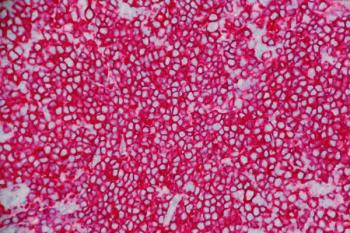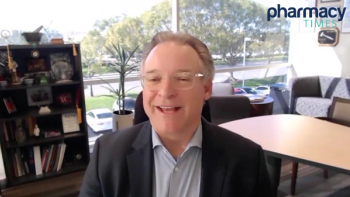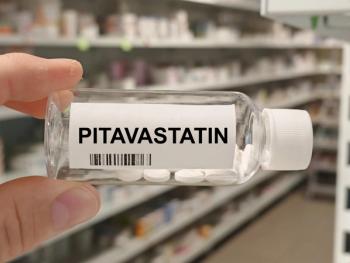
Pharmacy Practice in Focus: Health Systems
- November 2023
- Volume 12
- Issue 6
The Role of Tirofiban for Acute Coronary Syndrome Remains Unclear
The RESCUE BT2 trial sheds further light on the agent’s potential.
Tirofiban hydrochloride (Aggrastat; Medicure Pharma, Inc.) is a reversible competitive inhibitor of fibrinogen that binds to the glycoprotein IIb/IIIa receptor, a major receptor involved in platelet aggregation, and is indicated to reduce the rate of thrombotic cardiovascular events in patients with non-ST-segment elevation acute coronary syndrome (NSTE-ACS). Glycoprotein IIb/IIIa inhibitors are largely favored by health care professionals because they are platelet specific and do not affect platelet adhesion. Tirofiban has a half-life of approximately 120 minutes and is primarily cleared renally in its unchanged form.1
Tirofiban has been studied in a number of trials, each attempting to establish its role in therapy. In the PRISM-PLUS trial, tirofiban was found to decrease the number of adverse ischemic events in patients who presented with NSTE-ACS.2 The RESTORE trial was one of the first randomized, double-blind, placebo-controlled studies to examine the role of tirofiban in patients undergoing percutaneous coronary intervention (PCI) within 72 hours of presentation with ACS; the agent has shown efficacy vs placebo in this patient population but is not approved for this indication.3 In the ADVANCE trial investigating tirofiban’s use as adjunctive therapy in PCI complications, results showed that tirofiban significantly reduced the incidence of ischemic and thrombotic complications during high-risk PCI.4
Tirofiban is approved in combination with heparin for the treatment of ACS, but clinicians have struggled in recent years to find its true place in therapy.5 One area of interest has been its theoretical use in patients who have had a stroke.
P2Y12 inhibitors such as clopidogrel bisulfate (Plavix; Bristol Myers Squibb and Sanofi Pharmaceuticals), ticlopidine, ticagrelor (Brilinta; AstraZeneca), prasugrel (Effient; Daiichi Sankyo, Inc and Eli Lilly and Company), and cangrelor (Kengreal; Chiesi USA) are preferred treatments for patients because of their ability to lower the risk of bleeding complications without increasing the risk for ischemic events.6 Because tirofiban’s mechanism of action is similar to that of clopidogrel (one of the main medications used for primary and secondary prevention of stroke), multiple studies have examined tirofiban’s efficacy and safety in the treatment of ischemic stroke. Some findings have indicated that tirofiban may be effective for acute stroke in select patients.7,8
The RESCUE BT trial (ChiCTRIOR17014167) examined endovascular treatment with tirofiban vs placebo in patients with large vessel occlusion strokes and failed to show a difference in disability severity at 90 days between tirofiban and placebo.9 This led to the RESCUE BT2 trial (ChiCTR2000029502), which compared tirofiban to aspirin for the treatment of acute ischemic stroke in patients without large- or medium-sized vessel occlusion, a patient population with limited treatment options.10
The multicenter, double-blind, doubledummy, randomized phase 4 RESCUE BT2 trial was conducted in China and examined the effects of tirofiban in patients who presented with acute ischemic strokes and no evidence of complete occlusion in large- or medium-sized vessels. The study, with findings published in June 2023,10 set out to establish the safety and efficacy of tirofiban vs low-dose aspirin in adults who presented with the recent onset of ischemic stroke.
More than 1000 patients were enrolled in the RESCUE BT2 trial. Enrollment requirements were met if a patient was at least aged 18 years, had an ischemic stroke without occlusion of a large- or medium-sized vessel, had a National Institutes of Health Stroke Scale score of 5 or more, and had at least 1 moderately to severely weak limb. Patients also had to present with 1 of the 4 following clinical manifestations: ineligible for conventional reperfusion treatment, worsening or no improvement in stroke symptoms 24 to 96 hours after onset, early neurologic deterioration after treatment with antithrombolytics, or no improvement 4 to 24 hours after thrombolytic treatment. Some exclusions were evidence of a hemorrhage, renal insufficiency, pregnancy, or systolic blood pressure greater than 180 mm Hg or diastolic blood pressure greater than 110 mm Hg.
Patients assigned to the tirofiban group were given intravenous (IV) tirofiban plus an oral placebo for 48 hours, and those assigned to the aspirin group received 100 mg of aspirin plus an IV placebo of normal saline. After 2 days of treatment, all patients received 100 mg of aspirin for 90 days.
The primary end point of the study was an excellent outcome, defined as a score of 0 or 1 on the Modified Rankin Scale. The scores were assessed 90 days after randomization was completed. The secondary end points were favorable outcomes at 90 days, including functional independence, quality-of-life score, and neurological recovery score. The primary safety end points were death and symptomatic intracranial hemorrhage (ICH). The authors reported that among patients with stroke of recent onset or progression of stroke symptoms and nonoccluded large- and medium-sized cerebral vessels, tirofiban was associated with a greater likelihood of an excellent outcome than low-dose aspirin.10
The strengths of this trial were the large sample size, the broader population of patients, and the inclusion criteria of moderate to major motor deficits in at least 1 limb. Many of the patients who had been enrolled were assumed to have had a stroke through atherosclerotic origins, which provided a potential basis for a response to therapy that would block platelet aggregation and promote platelet disaggregation. This trial also did not include patients who had occlusions in large- or medium-sized vessels, which could limit its usefulness.10
The results of this trial showed that IV tirofiban was associated with a greater likelihood of a patient having an excellent outcome score on the Modified Rankin Scale than low-dose aspirin. The secondary end points resulted in no significant differences between tirofiban and low-dose aspirin. Although the incidence of symptomatic ICH was low in both groups, it was still higher in the tirofiban group than in the aspirin group.10
Given the lack of significant results in the RESCUE BT trial and the higher incidence of ICH and limitations of the RESCUE BT2 trial, it would be prudent to wait until more studies are conducted to establish the efficacy and safety of tirofiban and its role in ischemic strokes. Still, pharmacists should remain aware of the ongoing review of this potential new therapy for ischemic strokes.
References
1. Hashemzadeh M, Furukawa M, Goldsberry S, Movahed MR. Chemical structures and mode of action of intravenous glycoprotein IIb/IIIa receptor blockers: a review. Exp Clin Cardiol. 2008;13(4):192-197.
2. Pepine CJ. Adjunctive pharmacologic therapy for acute myocardial infarction. Clin Cardiol. 1994;17(1 suppl 1):I10-I14.
3. Hammock J, Steinhubl S, Ziada KM. Antiplatelet therapy. In: Jeremias A, Brown DL. Cardiac Intensive Care. 2nd ed. Elsevier Inc; 2010:452-469. doi:10.1016/B978-1-4160-3773-6.10037-0
4. Valgimigli M, Percoco G, Barbieri D, et al. The additive value of tirofiban administered with the high-dose bolus in the prevention of ischemic complications during high-risk coronary angioplasty: the ADVANCE trial. J Am Coll Cardiol. 2004;44(1):14-19. doi:10.1016/j.jacc.2004.03.042
5. McClellan KJ, Goa KL. Tirofiban. a review of its use in acute coronary syndromes. Drugs. 1998;56(6):1067-1080. doi:10.2165/00003495-199856060-00017
6. Feng WH, Chang YC, Lin YH, et al. P2Y12 inhibitor monotherapy versus conventional dual antiplatelet therapy in patients with acute coronary syndrome after percutaneous coronary intervention: a meta-analysis. Pharmaceuticals (Basel). 2023;16(2):232. doi:10.3390/ph16020232
7. Wu C, Sun C, Wang L, et al. Low-dose tirofiban treatment improves neurological deterioration outcome after intravenous thrombolysis. Stroke. 2019;50(12):3481-3487. doi:10.1161/STROKEAHA.119.026240
8. Lin L, Li W, Liu CC, et al. Safety and preliminary efficacy of intravenous tirofiban in acute ischemic stroke patient without arterial occlusion on neurovascular imaging studies. J Neurol Sci. 2017;383:175-179. doi:10.1016/j.jns.2017.10.041
9. RESCUE BT Trial Investigators; Qiu Z, Li F, Sang H, et al. Effect of Intravenous tirofiban vs placebo before endovascular thrombectomy on functional outcomes in large vessel occlusion stroke: the RESCUE BT randomized clinical trial. JAMA. 2022;328(6):543-553. doi:10.1001/jama.2022.12584
10. Zi W, Song J, Kong W, et al; RESCUE BT2 Investigators. Tirofiban for stroke without large or medium-sized vessel occlusion. N Engl J Med. 2023;388(22):2025-2036. doi:10.1056/NEJMoa2214299
About the Authors
Jeff Bruni is a 2024 PharmD candidate at William Carey University School of Pharmacy in Biloxi, Mississippi. His professional interests include critical care and infectious disease medicine with plans to pursue a PGY1 pharmacy residency.
Anne Dang-Vo is a 2024 PharmD candidate at William Carey University School of Pharmacy in Biloxi, Mississippi. Her professional interests include pediatrics, oncology, and emergency medicine with plans to pursue a PGY1 pharmacy residency.
Ron Welch, PharmD, BCPS, BCIDP, is a clinical lead specialist at Baptist Memorial Hospital-Golden Triangle in Columbus, Mississippi. He specializes in infectious disease and cardiology.
Articles in this issue
about 2 years ago
Data Show Cognitive Consequences of Benzodiazepine Useabout 2 years ago
Strategies to Help Eliminate Drug Exposure Risks in the WorkplaceNewsletter
Stay informed on drug updates, treatment guidelines, and pharmacy practice trends—subscribe to Pharmacy Times for weekly clinical insights.














































































































































































































